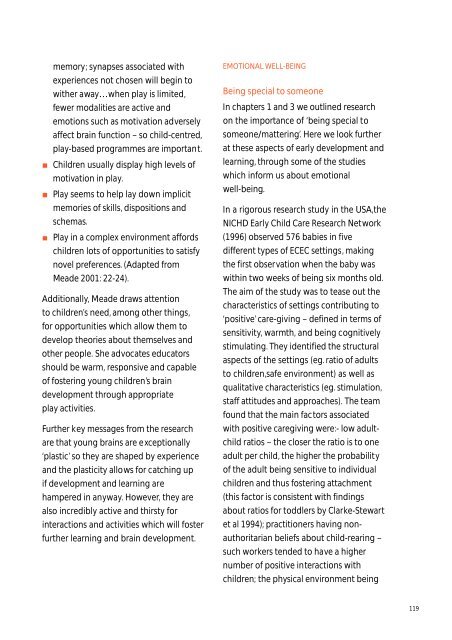Birth to three matters - Communities and Local Government
Birth to three matters - Communities and Local Government
Birth to three matters - Communities and Local Government
Create successful ePaper yourself
Turn your PDF publications into a flip-book with our unique Google optimized e-Paper software.
memory; synapses associated withexperiences not chosen will begin <strong>to</strong>wither away…when play is limited,fewer modalities are active <strong>and</strong>emotions such as motivation adverselyaffect brain function – so child-centred,play-based programmes are important.Children usually display high levels ofmotivation in play.Play seems <strong>to</strong> help lay down implicitmemories of skills, dispositions <strong>and</strong>schemas.Play in a complex environment affordschildren lots of opportunities <strong>to</strong> satisfynovel preferences. (Adapted fromMeade 2001: 22-24).Additionally, Meade draws attention<strong>to</strong> children’s need, among other things,for opportunities which allow them <strong>to</strong>develop theories about themselves <strong>and</strong>other people. She advocates educa<strong>to</strong>rsshould be warm, responsive <strong>and</strong> capableof fostering young children’s braindevelopment through appropriateplay activities.Further key messages from the researchare that young brains are exceptionally‘plastic’ so they are shaped by experience<strong>and</strong> the plasticity allows for catching upif development <strong>and</strong> learning arehampered in anyway. However, they arealso incredibly active <strong>and</strong> thirsty forinteractions <strong>and</strong> activities which will fosterfurther learning <strong>and</strong> brain development.EMOTIONAL WELL-BEINGBeing special <strong>to</strong> someoneIn chapters 1 <strong>and</strong> 3 we outlined re s e a rc hon the importance of ‘being special <strong>to</strong>someone/mattering’. Here we look furtherat these aspects of early development <strong>and</strong>learning, through some of the studieswhich inform us about emotionalwell-being.In a rigorous research study in the USA,theNICHD Early Child Care Research Network(1996) observed 576 babies in fivedifferent types of ECEC settings, makingthe first observation when the baby waswithin two weeks of being six months old.The aim of the study was <strong>to</strong> tease out thecharacteristics of settings contributing <strong>to</strong>‘positive’ care-giving – defined in terms ofsensitivity, warmth, <strong>and</strong> being cognitivelystimulating. They identified the structuralaspects of the settings (eg. ratio of adults<strong>to</strong> children,safe environment) as well asqualitative characteristics (eg. stimulation,staff attitudes <strong>and</strong> approaches). The teamfound that the main fac<strong>to</strong>rs associatedwith positive caregiving were:- low adultchildratios – the closer the ratio is <strong>to</strong> oneadult per child, the higher the probabilityof the adult being sensitive <strong>to</strong> individualchildren <strong>and</strong> thus fostering attachment(this fac<strong>to</strong>r is consistent with findingsabout ratios for <strong>to</strong>ddlers by Clarke-Stewartet al 1994); practitioners having nonauthoritarianbeliefs about child-rearing –such workers tended <strong>to</strong> have a highernumber of positive interactions withchildren; the physical environment being119
















